We have a tendency to treat our pets like babies, and sometimes that creates separation anxiety in dogs.
Humans have a desire to nurture anything small, cute or helpless.
When a newborn human baby cries, the right thing to do is go to her and offer comfort, food, warmth or whatever she needs, right?
It makes sense that we also want to carry our pets around, keep them near us at all times and go to them when they cry.
We shower them with affection whenever they display signs of neediness. This is a way for us to express love and feel loved back.
But loving a puppy or dog in this way can actually do some harm. It often (not always) results in an anxious, overly dependent, needy and annoying dog.
Puppies and dogs are not babies. They are animals, and they have a right to be treated as animals.
How to prevent separation anxiety in dogs
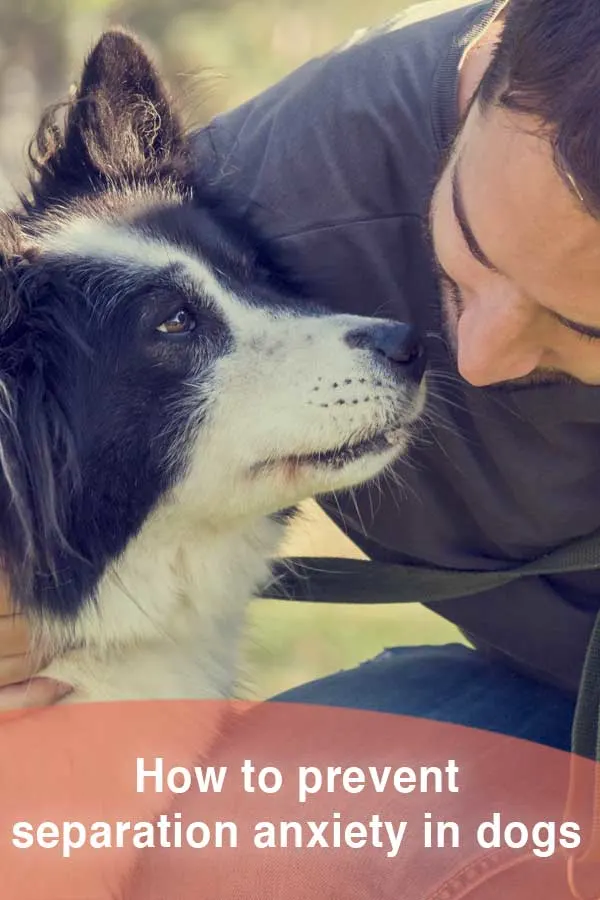
This post has been expanded into an ebook filled with tips on how to stop a dog’s separation anxiety. Order it here for $4.
What is dog separation anxiety?
Dogs with separation anxiety have not been conditioned to being left alone and therefore go into a frantic state of mind when separated from their owners (even when their owners are simply out of sight).
What is NOT dog separation anxiety?
Separation anxiety in dogs is overly diagnosed.
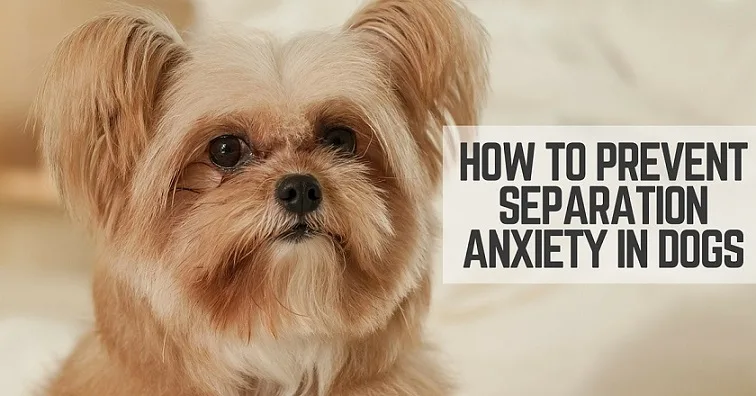
All dogs need a reasonable amount of time to adjust to a new home. Most dogs will cry in their kennels for a bit for the first couple of nights or weeks, but then they settle in just fine once they adjust to the new routine.
Some dogs are said to have “separation anxiety” when really they just need:
- exercise
- rules & training
- a routine
- time to adjust
A dog that is given little or no exercise, no mental stimulation (training or puzzle toys) and no time with a “pack” is going to be bored out of his mind.
Of course he’s going to bark, destroy property or rip apart his kennel when left alone. He has nothing else to do!
How do I know if my dog has separation anxiety?
In a past post, I outlined the symptoms of dog separation anxiety and the steps on how to help a dog with separation anxiety. Please check it out HERE.
In this post, I want to focus on preventing separation anxiety.
How do I prevent dog separation anxiety?
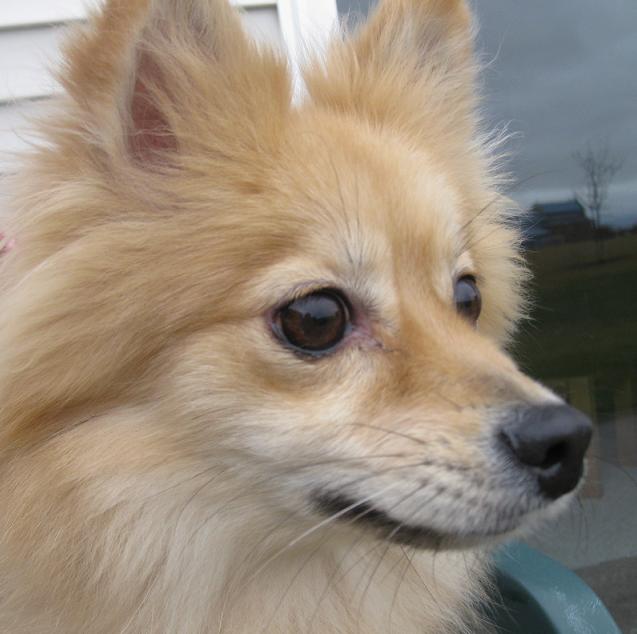
1. Do not carry your puppy everywhere.
A lot of small dogs develop separation anxiety because they are carried around all the time. They are literally treated like babies.
They never have to think for themselves. They are not encouraged to explore or be independent. They never learn proper socialization skills because their owners pick them up when the dogs are faced with anything new.
Some of these dogs become insecure, fearful and anxious without their owners in sight. Others become overly possessive of their owners and bite anyone who comes close. This can be prevented by treating the dog like a dog.
2. Teach your puppy to “stay” for long periods of time.
All dogs should be able to lie down and stay for at least a half-hour, especially when there are no distractions such as when you are watching TV or checking email.
This helps drain some mental energy, builds confidence and self-control.
Teach your dog to stay on her “place” or “bed” while you leave the room.
If your dog doesn’t have the most reliable down-stay quite yet, keep working on it.
Start with just 2 seconds while you’re right next to your dog. Then try 5 seconds and over time you can increase to 10 seconds, 15, 30. Eventually you can take one step away and she should remain staying. Then two steps.
It helps if you can give your dog a special chew toy like a Kong toy or a puzzle toy while she stays on her bed.
2. Do not pick your puppy up if she cries or jumps on you.
This is the kind of behavior you do not want to reward.
Unless she is truly in danger, completely ignore your dog when she cries or jumps on you for attention. Do not look at her. Do not scold her. Get up and leave the room if you have to. Your attention is a reward, and she only gets it when she is being calm and quiet and respectful.
By the way, I’m not saying it’s wrong to pick up and cuddle your dog! But if you are worried she is becoming too dependent on you or if she’s showing signs of separation anxiety, setting these boundaries will help her gain confidence in the long term.
*Enjoying this article? Get realistic dog training tips emailed once a week. Click Here
3. Reward your dog with attention when she is calm and quiet.
A reward can be something as simple as eye contact, a pat on the head or a treat. But this is also a good time to pick your dog up!
In the meantime, work on other ways to create temporary separation:
4. Purposely separate yourself from your puppy.
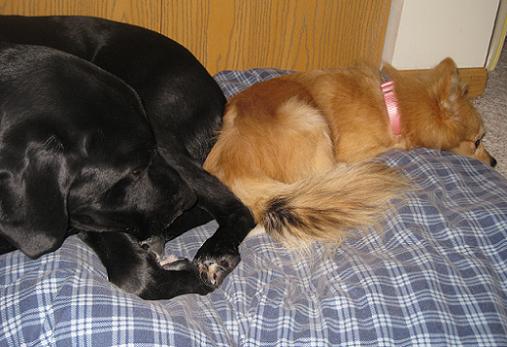
You and your dog will naturally want to be together, but you can’t be together all the time. It’s important to help puppies learn to feel comfortable being separated from you. Make sure you are creating these scenarios, even when you are home.
Some ideas to try for short periods:
Tether your dog to a chair or table and walk away.
Return only when she is quiet. This could take a few minutes. Heck, it could take an hour! If your puppy won’t stop crying, just wait her out and return when she has been quiet for even 3 seconds.
If she starts celebrating and barking as you approach, turn around and ignore her again until she is quiet. Having your attention is the greatest reward for your dog.
Kennel your dog when you are home.
This could be for 10 minutes or an hour. It’s the same concept as above.
Only return when your dog is quiet. Kenneling your dog when you are home will also help her feel more comfortable in her kennel because she won’t associate it with you leaving the house.
Make sure to stock the kennel full of goodies like Kongs filled with frozen peanut butter and treats.
Shut doors behind you.
If you have a pup who follow you into the bathroom, then close the door in her face and make her wait for you. This is an easy way to create temporary separation. If she scratches at the door or cries, do not open the door. Opening the door is too much of a reward.
Create boundaries.
Don’t let your puppy crawl into your lap unless she sits quietly first. Don’t let her sleep in your bed until she is a confident and well-trained dog. Puppies do not belong on the bed.

6. Stick to the same routine before you leave your dog home alone.
Sticking to a routine when you leave will really help your dog feel secure. Before you head to work, maybe you go for a 30-minute walk with your dog, then shower, then eat breakfast, then put her in her kennel and then do your makeup.
Dogs really depend on a routine to help them feel secure.
7. Ignore your dog 20 minutes before you leave and 10 minutes after you return.
Making an event out of coming or going confirms that being apart was bad.
Being apart is not bad, it’s normal.
So, completely ignore your dog before you leave the house (just for 10 minutes or so). Don’t talk to her. Don’t make eye contact. Don’t even look at her. Drawn-out goodbyes will only make her feel anxious. She will pick up on your feelings of guilt.
When you return, do the same. Do not look at her or acknowledge her at all (this is hard!). If she is barking in her kennel, that gives you even more reason to ignore her.
If you don’t kennel your dog and she greets you by jumping and crying, walk into another room like she doesn’t exist.
Return when she is relaxed. If you know she can’t relax, then simply have a Kong toy filled with peanut butter you can drop on the floor as you walk in the door and into another room, ignoring her.
Return in 5 or 10 minutes. This is the perfect time to take her for a walk.
8. Leave your puppy with a friend.
If you have an understanding friend who loves dogs, sometimes it helps if you can leave your dog with a friend for an hour here and there. This helps the dog associate positive experiences with people other than you.
If you are the primary caretaker of your dog, it can also be helpful to have other family members step up and take over some of the important roles like feeding the dog, training sessions, play or walks.
This is especially important if your dog seems overly attached to you vs. other family members or roommates.
Tip: Dogs usually love whoever takes them for walks!
9. Leave your puppy at a dog daycare occasionally.
I’m not saying you have to take your dog to dog daycare every day or every week, but it’s good for dogs to get out and stretch their boundaries every now and then without their owners hovering.
It’s good for the owners, too! It’s so hard for me to leave Ace somewhere overnight, but I know it’s good for me! I’m probably the one with separation anxiety.
10. Make sure all of your dog’s needs are being met.
Dogs that are not given any physical, mental or emotional challenges on a daily basis will likely be very anxious, hyperactive and “crazy” dogs.
Be fair to your dog and provide her with the daily exercise and training she needs. Spend time with her. Stretch her boundaries. And never assume that small dogs or “lazy” breeds do not need exercise. They do.
I fostered a Pomeranian mix named Elli who came to us with severe separation issues.
How did I help Elli?
I took her biking every day to get rid of her pent-up energy. She was about 9 pounds, and she would run 2 miles next to my bike with no problem! She loved it!
For more information, see my post on common sources for dog anxiety and what to do!
What additional tips do you have for preventing separation anxiety in dogs?
Separation anxiety is very time consuming to correct. It is stressful on the owner, the dog and all other family members and pets – and neighbors!
Related Article
*Enjoying this article? Get realistic dog training tips emailed once a week. Click Here
Lindsay Stordahl is the founder of That Mutt. She writes about dog training, dog exercise and feeding a healthy raw diet.


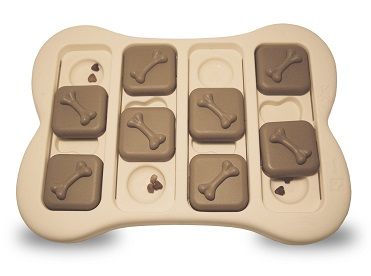

Kristina
Thursday 23rd of December 2021
I just inherited a lovely little 9 month old bichon frise puppy from my mom, who unfortunately no longer care for him due to health issues. My mom's adoration for him apparently taught him some bad habits. She never crated him. She took him everywhere with her- even to the grocery store. Whenever he whined for attention, she petted him or talked to him. As a result, he has developed velcro behavior, following me everywhere -even to the bathroom. He also cannot tolerate being left alone. While he doesn't destroy his crate (I started crating him), he does totally ignore even his most beloved toys, and cries incessantly, sometimes for hours. I'll try doubling his exercise to an hour and a half per day, introducing a thunder shirt, giving him relaxation chews, leaving the radio on, and desensitizing him to me leaving by "practicing" leaving and rewarding him for being calm. Thank you for the helpful blog!
Lindsay Stordahl
Friday 24th of December 2021
Good luck and be patient with him as you are. It takes time for them to adjust.
Kim Chappell
Friday 6th of September 2019
Excellent article! I would add trying the Thundershirt, I’ve had very good success with one of my dogs who in her later years developed separation anxiety. There is also a Thunder Ease spray which can be sprayed right on the Thundershirt. I saw a huge difference using the spray, it even stopped her seizures her anxiety caused. A weighted vest works extremely well for anxiety in dogs. I use and recommend the XDOG brand. Making sure the dog has plenty of exercise, both physical AND mental really helps. My ACD does two hours a day at a walk on his treadmill, his daily kibble is used as rewards for obedience and tricks, or in interactive toys like his Kong Wobbler and Snuffle Mat. We have also started doing Box Feeding, which uses up a huge amount of mental energy.
Daniel
Wednesday 12th of July 2017
Hello I have a 3.5 year old pitbull/catahoula with severe separation anxiety. We adopted her and her sister from a shelter in dallas. she is a great dog whenever we are home and she is with us. no issues at all. however her sister and her aren't getting along, this causes us to keep them separate in which we will put her in our master bedroom with food and water to lay down. Or when we have to work she will be put up in her kennel (escape proof, as she has destroyed any and all from petsmart. doing physical harm to herself trying to get out.) she will sweat and pant to the point of around a 1/2 inch of drool builds in the bottom of her kennel while we are away. she barks uncontrollably and it will take several hours for her to slowly start a calm down process but any slight noise and she will start again. she has dug through carpet and the concrete foundation under the carpet. I worry its getting to a point that we may have to re-home her. we do not want this to happen but fear our only option is to find the right home with someone who will not have to kennel or put her away as often. I'm curious if you have any suggestions on what we can do to try and break this or calm this habit? I feel the only thing i haven't tried is a thundershirt. what are your thought on this working with such a severe case? thank you for your time and thoughts.
Vicktoria Jones
Monday 10th of April 2017
Lindsay, the article is very educational but recently I and Oscar moved to the different state and I can see he is sad because he is missing my son, his cat and my sister. Do you have an advise for this type separation anxiety?
Sandy Weinstein
Monday 10th of April 2017
Evie never really had separation anxiety however, my youngest did and still does sometimes. she just tears up things like potty pads, takes the dead leaves out of plants or shreds her toys. i leave treats in the house, hiding for them to get when i leave. i also dont make it a big deal when i am leaving. however, they are waiting for me at the door when they see my car coming down the hill. i also put treats in the rock n' bowl for them to get.